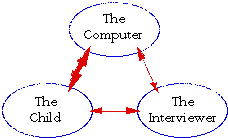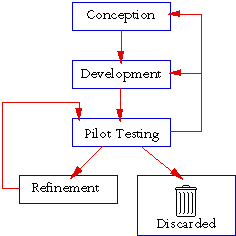1.Introduction
Since the early
1970's, researchers have sought to utilise computers to elicit information in situations
where paper-based questionnaires were previously used. Research has shown
that subjects are likely to respond more truthfully to computer-based questionnaires
than paper ones [Evans & Miller, 1969] [Johnson & Williams,
1977] [Koson et al, 1970]. This can be attributed to many factors,
but the user-interface is undoubtedly the most
significant. It seems that it is in some way easier to respond to a computer,
perhaps less embarrassing, than to a real person.
Notwithstanding these
encouraging results, early attempts at computer systems for the elicitation
of information simply took a questionnaire and "put it onto a computer". Users
were asked to read text which posed a series of questions and were invited to
type their answers, or use the keyboard to select from a list of alternatives.
Such interfaces were inflexible,
unforgiving and uninteresting; three major sins in interface design. However,
with the state of development of computer hardware at the time they were at the
limit of what was achievable. As more computing power became available to developers,
these systems were enhanced with features such as graphical interfaces,
coloured backgrounds and multiple fonts, but the same basic questionnaire approach
has still prevailed.
This thesis describes a software package aimed
primarily at children, for the
elicitation of information about feelings, places and people. The package attempts
to make more imaginative use of the power and flexibility available in modern
computer systems, and the techniques and observations which go to make up
the field of human-computer interaction. The intention was not only to utilise
the positive effect of computer-based systems referred to above, but also to include
extensive use of graphics and sound to capture the child's interest. Beyond
even this, the goal was to go
beyond the traditional questionnaire approach, and allow an interaction between
a child and computer more closely approximating to an interview. This demands
minimisation of text-based communication, and enabling children to express themselves
using more flexible, yet simple to use, alternatives.
1.1 History of The Project
In
1988, Dr. Rachel Calam, who was working at Alder Hey Children's hospital
in Liverpool, was involved in interviewing
a child that she suspected had been the victim of sexual abuse. The
child in question was keeping quiet about something, and Dr. Calam was trying
to find some way to lower the barrier to communication. At about the same time,
Dr. Calam had borrowed a Macintosh Plus computer to use at home, and had noticed
how easily her children had taken to using it. Dr. Calam thought that if there
was a computer system which used Macintosh graphics to represent personal and
family circumstances, such a
tool might help the child to disclose information about abuse, and overcome the
barriers to communication that occur when an adult interviews them.
Over
the duration of the project there has occurred a significant growth in multimedia
software designed for children for leisure and educational purposes - the
so called "edutainment" packages. The aim in this project was to produce something
more serious, something that would find out about the lives of children, and
how they may be suffering from
distress or harm. The initial goal was to produce a package which would help
in the disclosure of child sexual abuse, but as the project progressed and the
tools that were produced showed more widespread applicability, the aims widened,
to include any area where ascertaining the feelings of children about people,
places and events was of major importance.
In the case of this project,
when interviewing a child the whole raison d'etre of this package
was to give the child tools
which were simple and easily understood, yet could provide the flexibility to
identify and describe people, events, places and emotions. In order to do this,
metaphors used in the design of this interface were based upon things that children
would have come across, such as scrapbooks, comic strips and comic book
characters. Some aspects of the basic methods of interacting with the Macintosh
were suited to the task, and others required simplifying from Apple's original
Macintosh interface in order
to make interaction easier. Hence a number of adaptations were made, and new methods
of interacting with the package were developed. At the same time, some areas
of the study human-computer interaction were examined, and the lessons learned
were applied to the design and implementation of the various modules of the
package.
An important aspect of the package is that it is not intended
to replace the skilled interviewer, but should act as another "tool" available
to them. The package is designed
to help develop a triadic relationship between child, computer and interviewer
(see figure 1.1). Child and interviewer sit side-by-side in front of the computer,
with the child operating the various modules of the package, and the interviewer
able to offer advice and assistance when necessary. The interviewer can
ask the child questions relating to items that have arisen during the interview,
but since they are not face to face in a classic interview situation, the flow
of information is easier, and
the major axis of communication is seen to be between child and computer.

fig.
1.1 The triadic relationship - interviewer/child/computer.
The
package underwent continuous development in the light of user-feedback.
A number of the tools which were produced underwent significant changes as a result
of user-testing, and new ideas also came about as a result of upgrades to
the operating system of the Macintosh. As new facilities became available some
of them were incorporated into
the package (e.g. QuickTime - see Appendix B.11). The stages of development are
summarised in figure 1.2. Ideas were conceived and developed into modules which
were then tested on pilot groups. The results of the pilot studies then led
either to new ideas, or to the refinement of the existing ones. Occasionally, ideas
had to be discarded, even if they had undergone a number of refinements.

fig. 1.2 Stages of production of the package.
1.2 Overview of The Thesis
The next chapter summarises the psychological
aspects of the assessment of pain, and of interviewing, and specifically the
interviewing technique used by the team at Liverpool. Chapter three continues the
examination of background material by examining some of the current work being
carried out in the area of human-computer interaction. Chapter four examines
the design of the computer-based interviewing aide which is the subject of this
thesis, and how the various modules
of it relates to the non-computer-based interview. Some of the early changes
to the package are also detailed. Chapter five reports on results from trials
of some of the program modules with children. Chapter six discusses improvements
that have already been implemented, and chapter seven looks at possible future
enhancements, and the conclusions gathered from the project.
back to Index. forward to Chapter 2


